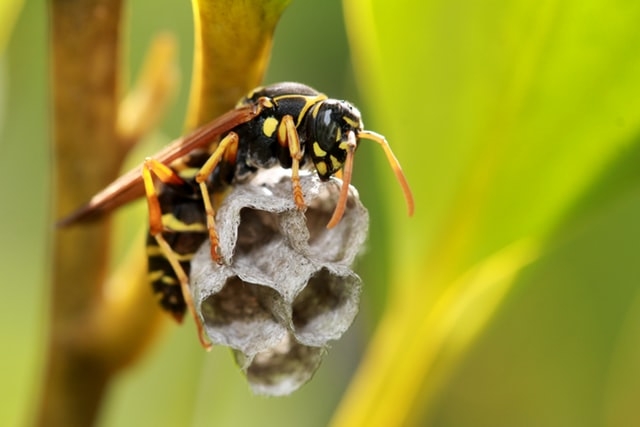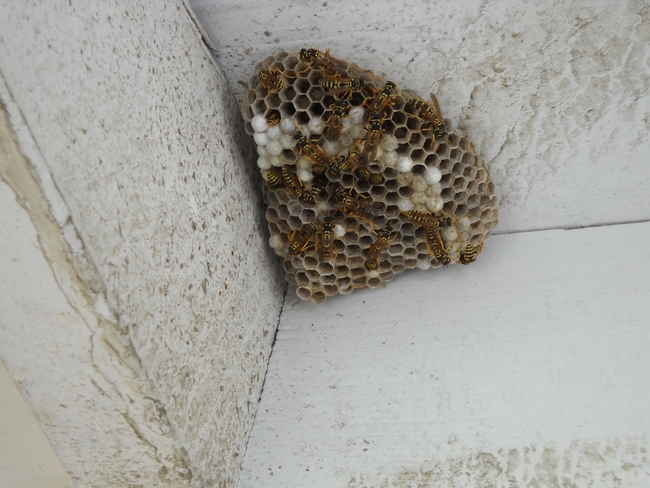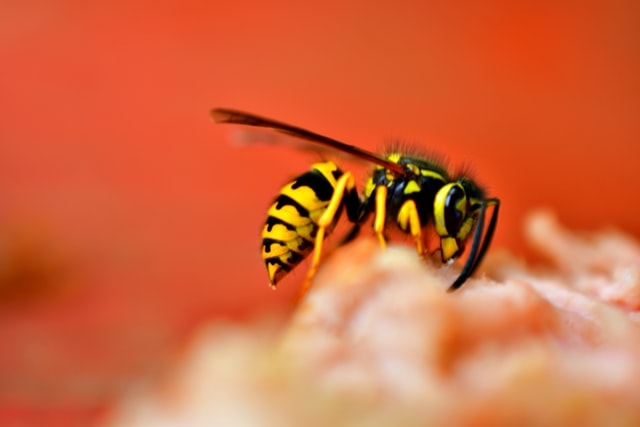It seems that everyone loves bees and thinks of them first thing when the topic is pollination and beneficial insects. Then, when the topic turns to wasps (and Yellowjackets) everyone changes their tune. To most people, wasps are mean, stinging attackers that can terrorize summer picnics. All of this is true, to a certain extent. That said, there is much more to know about wonderful wasps!
To start with, Aculeate wasps (those with stingers) came first. Bees are a branch of wasps that evolved to feed on pollen and nectar rather than caterpillars or flies. This transition was probably fairly smooth since many wasps visit flowers for nectar and prey items.
You are probably familiar with the paper wasps you find nesting under the eaves of your home. In addition, there are many other kinds of wasps. Some are specialists in the types of insect pests that they target, such as caterpillars or beetles. So if you want balance in your garden ecosystem and natural pest control, don't forget that wasps play a part. Here are some identifying factors and interesting facts:
Yellowjackets are 1⁄2 to 1 inch long with jagged bright yellow and black stripes. Their “waists” are barely visible. Unlike other common wasps, yellowjackets scavenge on human food. They nest in holes in the ground, inside wall cavities, or in hanging nests totally enclosed in gray paper with a single entrance. The western yellowjacket usually nests in the ground using an abandoned burrow, but occasionally nests in crawlspaces. Underground, the nest is a papery structure that provides a home and breeding area for the queen and contains cells where young are raised. Yellowjackets forage for a broad range of foods, but they often come into conflict with humans when they are attracted to meat, carbonated beverages, juices, desserts, deceased animals, and other food items.


Paper wasps have long slender waists, build paper nests with many open cells and are rarely aggressive. Paper wasps have long hind legs and a distinct constriction of the body between the thorax and abdomen. They are common in urban and suburban areas where they can build their papery nests under eaves of structures or in other protected locations. The benefits of wasps usually outweigh potential for harm unless a nest is in a high traffic area.
Mud daubers are dark-colored and thread-waisted. They build small, hard mud nests and rarely sting.
Paper wasps and yellowjackets are beneficial insects. They feed on caterpillars and other insects that could damage crops or ornamental plants in your garden. They also feed on house fly larvae.
Paper wasps aren't usually considered important pollinators, as they don't have pollen baskets or body hair that helps transport much pollen from plant to plant. For plants that require cross-pollination, like squash or melons, wasps aren't helpful. But for the many garden crops that largely self-pollinate, such as beans and tomatoes, wasps are a big help. The flowers of these plants still require “tripping,” a process that occurs when the stigma and anthers of a self-fertile flower make contact with each other due to a physical force from vibration (like wind) or, more efficiently, when an insect visits the flower. The tripping of bean flowers by visiting insects like wasps can increase bean yields .
As carnivores, wasps are not dependent on nectar like honeybees, but they do appear to enjoy a sweet drink. In fact, sophisticated “extrafloral nectaries” have evolved in some plants that encourage wasp visitation. These nectaries, commonly located on leaf petioles or near where they attach to plant stems, produce nectar that attracts wasps to protect the plant from pests. Considering that wasps are one of the most efficient predators of caterpillars in the garden, it is understandable that some plants have evolved to keep them around.
You might want to plant fava beans and cowpeas in your garden as they produce these extrafloral nectaries. Both of these plants attract not only wasps, but other beneficials as well, such as lady beetles and honeybees. Studies have shown that intercropping cowpeas with other crops reduces insect damage and is an effective integrated pest management (IPM) strategy.
This is the time of the year that wasps are re-emerging from winter hibernation and scouting for new nest sites. Unlike honeybees which produce stores of honey that see the entire colony through winter, it's only fertilized paper-wasp queens that live until the next year. These queens seek winter shelter in protected sites (such as your home), and then emerge in spring to find nest sites. If you find a wasp crawling inside your home this time of year, it is most likely a confused queen trying to find a way out. Rather than squashing her, help her find her way out, as they rarely sting without a nest to defend.
This is also the time of year that you can help wasps choose appropriate nesting sites. Their favorite nest sites will be under the eaves of your home, so consider leaving them there if not in a high traffic area. Paper wasps usually only sting to guard their nest or if they feel threatened by a human that is swatting madly at them, so give them room to feel safe. If you do not like the location that a wasp queen has chosen to begin building her nest, simply knock it down while the nest is small and new, without any defenders to protect it… she'll likely find another building site.
Most people don't want to have wasps living alongside them, but wasps are so beneficial for their pest control capabilities that, if you can possibly leave the nest alone, it is advisable to do so. If you discover a nest that needs to be removed, UC IPM has information about thier control. See this webpage for more information. http://ipm.ucanr.edu/PMG/PESTNOTES/pn7450.html
Wasps spend their summers seeking out aphids, flies, caterpillars and other bugs - many of them pests - to feed to their larvae. Hundreds, or even thousands, of larvae can be produced each year in a paper wasp hive, so they get through a lot of bugs!
The best way to avoid being stung is to treat wasps with respect. Move calmly and deliberately, give them space to go about their business, and they will generally ignore you. If you are stung and have an extreme reaction get to the ER fast.
